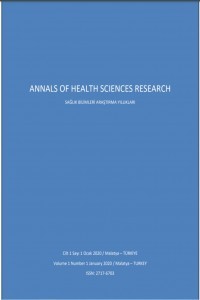Biyofilm ve Endodonti: Bölüm 1
Biyofilm, Dental plak, Antimikrobiyal, Endodontik biyofilmler
Biofilm and Endodontics: Part 1
Biofilm, Dental plaque, Antimicrobial, Endodontic biofilms.,
___
- 1. Costerton W, Geesey GG, Cheng KJ. How bacteria stick. Sci Am 1978; 238: 86–95.
- 2. Elder MJ, Stapleton F, Evans E, Dart JK. Biofilmrelated infections in ophthalmology. Eye 1995; 9: 102-9.
- 3. Donlan MR, Costerton W. Biofilms: Survival mechanisms of clinically relevant microorganisms. Clin Microbiol Rev 2002; 15: 167-93.
- 4. Caldwell DE, Atuku E, Wilkie DC, et al. Germ theory vs. community theory in understanding and controlling the proliferation of biofilms. Adv Dent Res 1997; 11: 4-13.
- 5. Flemming HC, Wingender J. Biofilm the matrix. Nat Rev Microbiol 2010; 8: 623-33.
- 6. Donlan RM. Role of biofilms in antimicrobial resistance. ASAIO J 2000; 46: 47-52.
- 7. Ingle JI, Bakland L, Baumgartner JC. Ingle’s Endodontics 6. In: Baumgartner JC, Siquera JF Jr, Sedgley CM, Kishen A. Microbiology of Endodontic Disease. 6th ed. BC Decker 2008: 270- 85.
- 8. Antunes LCM, Ferreira RBR, Buckner MMC, Finlay BB. Quorum sensing in bacterial virulence. Microbiol 2011; 156: 2271–82.
- 9. Miller MB, Bassler BL. Quorum sensing in bacteria. Annu Rev Microbiol 2001; 55: 165–99.
- 10. Mah TFC, O'Toole GA. Mechanisms of biofilm resistance to antimicrobial agents. Trends Microbiol 2001; 9: 34-9.
- 11. Costerton JW, Stewart PS, Greenberg EP. Bacterial biofilms: a common cause of persistent infections. Science 1999; 284: 1318-22.
- 12. Donlan RM. Biofilm formation: a clinically relevant microbiological process. Clin Infect Dis 2001; 33: 1387-92.
- 13. Svensater G, Bergenholtz G. Biofilms in endodontic infections. Endod Topics 2004; 9: 27– 36.
- 14. Marsh PD. Dental plaque as a microbial biofilm. Caries Res 2004; 38: 204-11.
- 15. Nair PNR. Apical periodontitis: a dynamic encounter between root canal infection and host response. Periodontol 2000 1997; 13: 121–4.
- 16. Siqueira JF Jr. Aetiology of root canal treatment failure: why well-treated teeth can fail. Int Endod J 2001; 34: 1-10.
- 17. Hargreaves KM, Cohen S. Cohen’s Pathways of the Pulp. In: Siqueira FJ Jr, Roças IN. Microbiology and Treatment of Endodontic Infections. 10th Ed. Elsevier-Health Sciences Division 2010: 569-71.
- 18. Wang J, Jiang Y, Chen W, Zhu C, Liang J. Bacterial flora and extraradicular biofilm associated with the apical segment of teeth with post-treatment apical periodontitis. J Endod 2012; 38: 954-9.
- 19. Leonardo MR, Rossi MA, Silva AB, Ito IY, Bonifa’cio KC. EM evaluation of bacterial biofilm and microorganisms on the apical external root surface of human teeth. J Endod 2002; 28: 815-8.
- 20. Noguchi N, Noiri Y, Narimatsu M, Ebisu S. Identification and localization of extraradicular biofilm-forming bacteria associated with refractory endodontic pathogens. Appl Environ Microbiol 2005; 71: 8738–43.
- 21. Noiri Y, Ehara A, Kawahara T, Takemura N, Ebisu S. Participation of bacterial biofilms in refractory and chronic periapical periodontitis. J Endod 2002; 28: 679-83.
- 22. Sunde PT, Olsen I, Debelian GJ, Tronstad L. Microbiota of periapical lesions refractory to endodontic therapy. J Endod 2002; 28: 304-10.
- 23. Takemura N, Noiri Y, Ehara A, Kawahara T, Noguchi N, Ebisu S. Single species biofilmforming ability of root canal isolates on guttapercha points. Eur J Oral Sci 2004; 112: 523–9.
- 24. George S, Basrani B, Kishen A. Possibilities of gutta-percha-centered infection in endodontically treated teeth: an in vitro study. J Endod 2010; 36: 1241–4.
- 25. Araki AT, Ibraki Y, Kawakami T, Lage-Marques JL. Er:Yag laser irradiation of the microbiological apical biofilm. Braz Dent J 2006; 17: 296-9.
- 26. Noiri Y, Katsumoto T, Azakami H, Ebisu S. Effects of Er:YAG laser irradiation on biofilmforming bacteria associated with endodontic pathogens in vitro. J Endod 2008; 34: 826–9.
- 27. Chavez de Paz LE, Bergenholtz G, Svensater G. The effects of antimicrobials on endodontic biofilm bacteria. J Endod 2010; 36: 70–7.
- 28. Shen Y, Stojicic S, Qian W, Olsen I, Haapasalo M. The synergistic antimicrobial effect by mechanical agitation and two chlorhexidine preparations on bofilm bacteria. J Endod 2010; 36: 100-4.
- Başlangıç: 2012
- Yayıncı: İnönü Üniversitesi
Hipertansiyon ve Hipertansif Hastalarda Anestezi
Geriatrik Hemodiyaliz Hastalarında Diyabet Varlığının Trombosit İndekslerine Etkisi
Recep BENTLİ, Süleyman KÖZ, Abdulvahap COŞKUN, İdris ŞAHİN
Amalgam, Kompozit ve Cam İyonomer Simanların Isı İletkenlik Özelliklerinin İncelenmesi
Ali KELEŞ, Fuat AHMETOĞLU, Muhammet YALÇIN, Neslihan ŞİMŞEK, Elçin T BULUT, Şendoğan KARAGÖZ
Skrotal Sebase Kistle Karışabilen Nadir Bir Skrotum Hastalığı: İdiyopatik Skrotal Kalsinozis
Ramazan ALTINTAŞ, Fatih OĞUZ, Ali BEYTUR, Serhan ÇİMEN, Ali GÜNEŞ
Biyofilm ve Endodonti: Bölüm 1
Neslihan ŞİMŞEK, Elçin Tekin BULUT
Dişeti Enflamasyonun Tedavisinde Gaz Ozonun Klinik Etkilerinin Değerlendirilmesi
Aminoguanidin ve Kardiyovasküler Sistem
Hakan PARLAKPINAR, Mehmet Hamdi ÖRÜM, Ahmet ACET
Rüptüre Kist Hidatik Nedeniyle Gelişen Alerjik Reaksiyon
Mustafa Said AYDOĞAN, Mehmet Ali ERDOĞAN, Ülkü ÖZGÜL, Yusuf Ziya ÇOLAK, Mahmut DURMUŞ
Agresif ve Kronik Periodontitisli Hastalarda Ağız Kokusunun Karşılaştırılması
